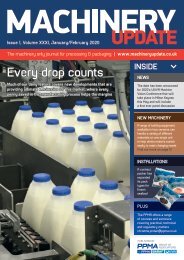MU 2017 November December
- No tags were found...
Create successful ePaper yourself
Turn your PDF publications into a flip-book with our unique Google optimized e-Paper software.
52 MACHINERY UPDATE NOVEMBER/DECEMBER <strong>2017</strong> www.machineryupdate.co.uk<br />
Feature: Pharmaceuticals<br />
With the<br />
deadline for<br />
compliance fast<br />
approaching,<br />
machine<br />
builders and packaging<br />
manufacturers do not have<br />
much longer to ensure<br />
pharmaceutical and medical<br />
production meets the<br />
requirements of the Falsified<br />
Medicines Directive (FMD).<br />
There has been plenty<br />
of time to prepare for the<br />
February 2019 deadline<br />
and to develop solutions<br />
to ensure packs carry the<br />
required unique, traceable<br />
serial number. “Of course<br />
companies also have to use<br />
tamper-evident systems to<br />
protect packs from being<br />
opened and reclosed,”<br />
says David Hannaby, Sick’s<br />
UK product manager for<br />
presence detection.<br />
The requirements to<br />
combat tampering are further<br />
specified in standard<br />
EN 16679:2015-03 ‘Packaging<br />
– tamper verification features<br />
for medicinal production<br />
packaging’.<br />
DEVISING THE SEALS<br />
Manufacturers of labels<br />
and labelling machinery<br />
have devised a variety of<br />
self-adhesive seals that show<br />
irreversible, visible evidence<br />
whenever someone tries to<br />
open and reclose a pack.<br />
Seals made from transparent<br />
films or foils are particularly<br />
popular with packaging<br />
designers because they do not<br />
compromise the packaging<br />
design, or cover up any<br />
other markings.<br />
Ensuring the transparent<br />
seal is correctly applied to<br />
Glare looks for high-gloss surfaces<br />
The Glare sensor is easy to integrate into both new and existing machinery and comprises a central strip of eight<br />
LED emitters surrounded by two receiver lines, which make it resistant to vibration or any product ‘wobble’<br />
Glossy seals<br />
are perfect<br />
Machinery Update talks to Sick UK about technology<br />
that helps compliance with tamper evident seal needs<br />
the packaging during the<br />
production process every time<br />
is vital to achieve compliance.<br />
An optical sensor is deployed<br />
on the machine to verify<br />
the presence of the seal,<br />
label or mark on each pack.<br />
However, transparent seals<br />
are glossy. The packaging<br />
they are attached to may<br />
also be reflective, so they<br />
pose challenges for accurate<br />
detection by photo-electric<br />
devices that are ‘confused’<br />
by the diffusion of light<br />
reflections from the gloss<br />
seal and the surrounding<br />
materials.<br />
With the new regulations<br />
approaching, Sick turned<br />
the problem of gloss into an<br />
opportunity and developed<br />
a sensor that actually looks for<br />
a high-gloss surface.<br />
The Glare product from Sick<br />
recognises and differentiates<br />
between surfaces according<br />
to how glossy they are.<br />
It does this by analysing the<br />
spatial distribution of the<br />
reflected light using Sick’s<br />
Delta-S technology. It can tell<br />
the difference between the<br />
gloss of the seal and the more<br />
scattered, diffuse reflections<br />
from the packaging material.<br />
As a result, Glare delivers<br />
nearly 100% detection rates.<br />
It can be tailored to the<br />
specific process and can be set<br />
up using a simple three-point<br />
teach-in method to evaluate<br />
the gloss properties of the<br />
seal, the packaging and the<br />
background.<br />
The Glare sensor is a compact<br />
(42.5 x 44 x 43.4mm), all-inone<br />
IP67 unit. It comprises


















